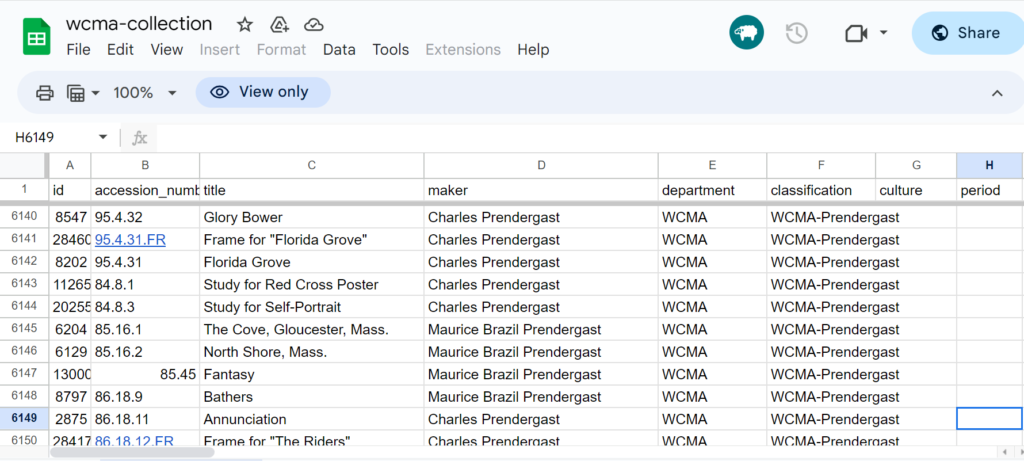
In what way is this data? In what way is it metadata?
Christoph Schoch defines data in the humanities as “a digital, selectively constructed, machine-actionable abstraction representing some aspects of a given object of humanistic inquiry.” The google sheets export of the WCMA collection suits that definition perfectly. The items in the WCMA collection and their various aspects are represented in the form of an online spreadsheet, not a physical catalog. Also, the categories included in the spreadsheet (such as the title, maker, and creation date of an object) were intentionally chosen, or constructed, by the curator(s) of WCMA who deemed those categories essential for the management and display of the museum’s historical objects. This is why the provided spreadsheet qualifies as “data.” However, one might also call it “metadata,” which means data about data. In that case, the ID, accession number, and the title of historical objects would be data, whereas additional information such as the time of their creation and their medium would be considered metadata.
Imagine you are writing a datasheet to contextualize this data set. What are three topics or questions that you would want to address in the datasheet? For each of the three things, briefly explain why it is relevant for this data set.
First, I would address how exactly this data set was created and collected. This is important because the data set we are looking at is so extensive and messy. The datasheet should make the meaning of each item and the relations between items more explicit. Second, I would address what data is missing and why. In this particular data set, some historical objects have “description” and others do not. The same goes with “copyright holder,” “inscription,” and so on. The presence of data can tell us a lot about an item, but a lack thereof can too. For example, a piece of painting might not have an identifiable painter because it was produced at a certain place and period of time when it was socially unacceptable for women to be painters. Although this is just one example, the point is that, when there are holes in a data set, it is important to take them into account and consider why those holes are there in the first place. Third, I would address the fact that this data set cannot fully capture the meaning, significance, and nuance of the historical objects in WCMA. While the data set is certainly helpful in understanding the WCMA collection, close reading of each historical object is also necessary.
What fields don’t exist that you might want to have about this collection? Where could someone get the information to fill in that data?
I would like to know the identities of the artists, such as their gender, race, and nationality. That information will help WCMA diversify their collection in case it disproportionately represents artists from dominant social groups. Another field that I would like to know more about is the art styles that each item belongs to. For example, we could mark an item as “expressionist painting” or “impressionist painting.” Although we already have the creation date included in the spreadsheet and use that to predict what kind of art trend(s) must have influenced the object, it would be much more convenient if the information were made explicit in the spreadsheet.
